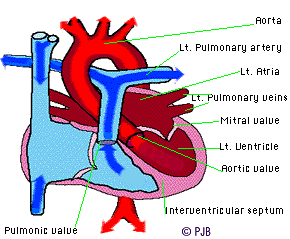Normal Blood Flow Review
 Normal Cardiac Blood Flow
Normal Cardiac Blood Flow
The normal heart efficiently circulates oxygenated blood from the lungs to the body tissues, where oxygen is utilized for cellular function. Simultaneously, deoxygenated blood is returned to the lungs for reoxygenation. This process requires coordinated and forceful contractions of the cardiac muscle in the atria and ventricles, coupled with the proper opening and closing of the heart valves to generate sufficient pressure and prevent the backward flow of blood during each cardiac cycle.
Oxygenated Blood Pathway:
- Pulmonary Veins to Left Atrium: Oxygenated blood (depicted as red) returns from the lungs to the left atrium (LA) via the pulmonary veins.
- Left Atrium to Left Ventricle: This oxygen-rich blood then flows from the LA, through the mitral valve (also known as the bicuspid valve), into the left ventricle (LV).
- Left Ventricle to Systemic Circulation: During ventricular systole (contraction), the mitral valve closes to prevent backflow, and the LV forcefully ejects the oxygenated blood through the aortic valve into the aorta. From the aorta, this blood is distributed to the systemic circulation, supplying oxygen and nutrients to all tissues and organs of the body.
Deoxygenated Blood Pathway:
- Systemic Circulation to Right Atrium: Deoxygenated blood (depicted as blue), carrying carbon dioxide and metabolic waste products, returns from the body to the right atrium (RA) via the superior vena cava (from the upper body) and the inferior vena cava (from the lower body).
- Right Atrium to Right Ventricle: This deoxygenated blood then flows from the RA, through the tricuspid valve, into the right ventricle (RV).
- Right Ventricle to Pulmonary Circulation: During ventricular systole, the tricuspid valve closes, and the RV pumps the deoxygenated blood through the pulmonic valve into the pulmonary artery. The pulmonary artery carries this blood to the lungs, where carbon dioxide is exchanged for oxygen.
Valvular Function:
The unidirectional flow of blood through the heart is ensured by the precise opening and closing of the four heart valves:
- Mitral Valve: Located between the LA and LV.
- Tricuspid Valve: Located between the RA and RV.
- Aortic Valve: Located between the LV and the aorta.
- Pulmonic Valve: Located between the RV and the pulmonary artery.
These valves act as one-way gates, preventing backflow and maintaining the pressure gradients necessary for efficient blood circulation.
Additional patient teaching resources
National Heart, Lung, and Blood Institute Resource: The National Heart, Lung, and Blood Institute provides excellent consumer learning resources for the patient family. (Keep this as it's a valuable resource).
© RnCeus.com
 Normal Cardiac Blood Flow
Normal Cardiac Blood Flow Normal Cardiac Blood Flow
Normal Cardiac Blood Flow